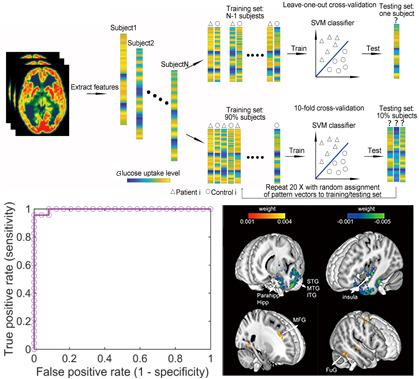当前位置:
X-MOL 学术
›
J. Neurosci. Res.
›
论文详情
Our official English website, www.x-mol.net, welcomes your
feedback! (Note: you will need to create a separate account there.)
Characterizing the hyper- and hypometabolism in temporal lobe epilepsy using multivariate machine learning
Journal of Neuroscience Research ( IF 2.9 ) Pub Date : 2021-09-09 , DOI: 10.1002/jnr.24951 Dongyan Wu 1 , Liyuan Yang 2 , Gaolang Gong 2 , Yumin Zheng 3 , Chaoling Jin 3 , Lei Qi 4 , Yanran Li 4 , Di Wu 4 , Zaixu Cui 5 , Xiaosong He 6 , Liankun Ren 7
Journal of Neuroscience Research ( IF 2.9 ) Pub Date : 2021-09-09 , DOI: 10.1002/jnr.24951 Dongyan Wu 1 , Liyuan Yang 2 , Gaolang Gong 2 , Yumin Zheng 3 , Chaoling Jin 3 , Lei Qi 4 , Yanran Li 4 , Di Wu 4 , Zaixu Cui 5 , Xiaosong He 6 , Liankun Ren 7
Affiliation

|
Mesial temporal lobe epilepsy (MTLE) is the most common type of focal epilepsy, presenting both structural and metabolic abnormalities in the ipsilateral mesial temporal lobe. While it has been demonstrated that the metabolic abnormalities in MTLE actually extend beyond the epileptogenic zone, how such multidimensional information is associated with the diagnosis of MTLE remains to be tested. Here, we explore the whole-brain metabolic patterns in 23 patients with MTLE and 24 healthy controls using [18F]fluorodeoxyglucose PET imaging. Based on a multivariate machine learning approach, we demonstrate that the brain metabolic patterns can discriminate patients with MTLE from controls with a superior accuracy (>95%). Importantly, voxels showing the most extreme contributing weights to the classification (i.e., the most important regional predictors) distribute across both hemispheres, involving both ipsilateral negative weights over the anterior part of lateral and medial temporal lobe, posterior insula, and lateral orbital frontal gyrus, and contralateral positive weights over the anterior frontal lobe, temporal lobe, and lingual gyrus. Through region-of-interest analyses, we verify that in patients with MTLE, the negatively weighted regions are hypometabolic, and the positively weighted regions are hypermetabolic, compared to controls. Interestingly, despite that both hypo- and hypermetabolism have mutually contributed to our model, they may reflect different pathological and/or compensative responses. For instance, patients with earlier age at epilepsy onset present greater hypometabolism in the ipsilateral inferior temporal gyrus, while we find no evidence of such association with hypermetabolism. In summary, quantitative models utilizing multidimensional brain metabolic information may provide additional assistance to presurgical workups in TLE.
中文翻译:

使用多元机器学习表征颞叶癫痫的高代谢和低代谢
颞叶内侧癫痫(MTLE)是最常见的局灶性癫痫类型,表现为同侧颞叶内侧结构和代谢异常。虽然已经证明 MTLE 中的代谢异常实际上超出了致癫痫区,但这些多维信息如何与 MTLE 的诊断相关仍有待检验。在这里,我们使用 [ 18 ] 探索 23 名 MTLE 患者和 24 名健康对照者的全脑代谢模式。F]氟脱氧葡萄糖PET成像。基于多变量机器学习方法,我们证明了大脑代谢模式可以以更高的准确度(>95%)将 MTLE 患者与对照组区分开来。重要的是,显示对分类贡献最大权重的体素(即最重要的区域预测因子)分布在两个半球,包括颞叶外侧和内侧前部、岛叶后部和眶额外侧回的同侧负权重,以及对侧前额叶、颞叶和舌回的正权重。通过感兴趣区域分析,我们验证了与对照组相比,在 MTLE 患者中,负权区域是低代谢的,而正权区域是高代谢的。有趣的是,尽管低代谢和高代谢都对我们的模型做出了相互贡献,但它们可能反映了不同的病理和/或补偿反应。例如,癫痫发作年龄较小的患者在同侧颞下回表现出更大的低代谢,而我们没有发现这种与高代谢相关的证据。总之,利用多维脑代谢信息的定量模型可以为 TLE 的术前检查提供额外的帮助。虽然我们没有发现这种与高代谢相关的证据。总之,利用多维脑代谢信息的定量模型可以为 TLE 的术前检查提供额外的帮助。虽然我们没有发现这种与高代谢相关的证据。总之,利用多维脑代谢信息的定量模型可以为 TLE 的术前检查提供额外的帮助。
更新日期:2021-09-09
中文翻译:

使用多元机器学习表征颞叶癫痫的高代谢和低代谢
颞叶内侧癫痫(MTLE)是最常见的局灶性癫痫类型,表现为同侧颞叶内侧结构和代谢异常。虽然已经证明 MTLE 中的代谢异常实际上超出了致癫痫区,但这些多维信息如何与 MTLE 的诊断相关仍有待检验。在这里,我们使用 [ 18 ] 探索 23 名 MTLE 患者和 24 名健康对照者的全脑代谢模式。F]氟脱氧葡萄糖PET成像。基于多变量机器学习方法,我们证明了大脑代谢模式可以以更高的准确度(>95%)将 MTLE 患者与对照组区分开来。重要的是,显示对分类贡献最大权重的体素(即最重要的区域预测因子)分布在两个半球,包括颞叶外侧和内侧前部、岛叶后部和眶额外侧回的同侧负权重,以及对侧前额叶、颞叶和舌回的正权重。通过感兴趣区域分析,我们验证了与对照组相比,在 MTLE 患者中,负权区域是低代谢的,而正权区域是高代谢的。有趣的是,尽管低代谢和高代谢都对我们的模型做出了相互贡献,但它们可能反映了不同的病理和/或补偿反应。例如,癫痫发作年龄较小的患者在同侧颞下回表现出更大的低代谢,而我们没有发现这种与高代谢相关的证据。总之,利用多维脑代谢信息的定量模型可以为 TLE 的术前检查提供额外的帮助。虽然我们没有发现这种与高代谢相关的证据。总之,利用多维脑代谢信息的定量模型可以为 TLE 的术前检查提供额外的帮助。虽然我们没有发现这种与高代谢相关的证据。总之,利用多维脑代谢信息的定量模型可以为 TLE 的术前检查提供额外的帮助。











































 京公网安备 11010802027423号
京公网安备 11010802027423号